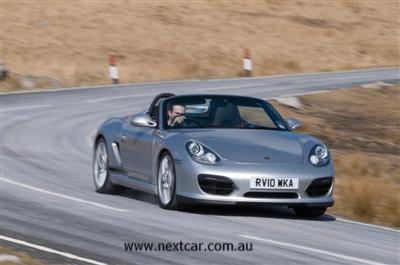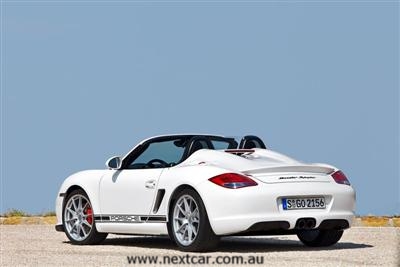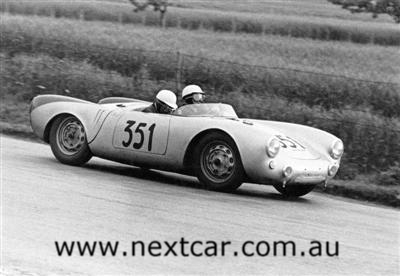Porsche Boxster Spyder released in Europe
|
|
|

 With a small fuel tank, no radio or air conditioning,
With a small fuel tank, no radio or air conditioning,
this Porsche presents with a 'poverty pack'.
|
|
|
Home >
News >
Porsche
28th March, 2010
- Light weight, purist model offers authentic roadster experience
- 80 kg lighter than equivalent Boxster S model
- Bolder, more powerful and sportier than ever
The light weight version of the mid-engined Porsche Boxster roadster has now been released in Europe.
The new Boxster Spyder represents the true, purist form of the Porsche sports car – light, powerful,
open-roofed and very efficient.
This is the formula applied in making the most successful road-going sports and racing cars throughout
the history of Porsche, ranging from the legendary 550 Spyder of the 1950s to the RS Spyder Le Mans
Prototype race car so successful in motor sport today.
Weighing 1,275 kg, the Boxster Spyder is the lightest model in the Porsche line-up, and continues this
clear-cut philosophy in a package offering full homologation for the road, and fulfilling a popular wish
expressed by Porsche customers.
The new model becomes the third version in the Boxster range, joining the Boxster and Boxster S, yet at
first sight stands out clearly from the other models. This is quite simply because the Spyder has been
developed essentially for driving in the open air.
Bold and sporty styling
The Porsche Boxster Spyder is first and foremost a Boxster – but interpreted in a totally new way. The
purist 'character' of the car is evident at first sight, with particular emphasis on the two-seater
roadster design with its mid-engine. The new, elegantly long rear lid, together with new wheels and
distinctive styling touches inside and out, give the car an absolutely unique look.
The low-slung, light weight soft top extends far to the rear at a distinctive angle and serves to
protect the driver and passenger from bright sunshine, wind and rain. When closed, the soft top, together
with the bespoke, shallower side windows and the two unique striking bulges on the single-piece rear
engine cover, boasts a stretched and sleek silhouette reminiscent of the Carrera GT super sports car.
And classic "Porsche" logos run along the bottom of each door as a 'leitmotif' inspired by earlier
Porsche Spyder race cars.
The main objective of the Porsche Design Studio in designing the Boxster Spyder was to make the classic
design of the current Boxster S even purer and to make clear reference to classic Porsche racing cars.
Great importance was placed on emphasising the car’s functions. The design of the manual roof is intended
to perfect the silhouette.
Two convex curves running lengthwise in the completely new aluminium rear lid, the fixed rear spoiler
and a modified front spoiler lip help to optimise the car’s aerodynamics. As you would expect, the
aerodynamic qualities of the Porsche Boxster Spyder have been honed for superior driving dynamics. The
aerodynamic Cd rating of 0.30 is identical to the Boxster S, while the drag (Cd x A) is, in fact, lower
due to the smaller frontal area. The excellent aerodynamics makes a significant contribution to the
agility of the car at speed, and also to low fuel consumption.
Significantly, the Spyder weighs 80 kg less than the Boxster S which, combined with a lower centre of
gravity and revised chassis settings, gives the Boxster Spyder the calibre of driving dynamics that
clearly reflect the unique look of the car.
Higher performance through intelligent weight reduction
While the overall objective behind the Porsche Boxster Spyder was to improve performance, this has been
achieved in an intelligent way, not simply by boosting engine power. Instead, every detail was scrutinised
to deliver the required dynamic responses, with the driver’s needs – as is typical of Porsche - the
primary focus.
The obvious point of difference between the Boxster Spyder and its 'siblings' is its manual roof instead
of an electric folding one, and the use of a large aluminium rear lid, that not only provides that
essential ‘speedster’ look, but also contributes to the car’s light weight and thrilling performance.
The purist qualities of the Spyder are delivered by a comprehensive programme of light weight features:
- manual fabric roof with carbon fibre front frame reduces the Spyder’s weight by 21 kg
- aluminium doors similar to those on the 911 Turbo and GT3 saves 15 kg
- the use of an aluminium rear engine cover saves 3 kg
- since the Spyder was designed for sporty open-top driving, the air conditioning has been removed and saves 12 kg
- using light weight carbon fibre sports bucket seats saves 12 kg
- the fuel tank has a capacity of 54 litres, 10 litres fewer than standard Boxster, saving 7 kg
- the light weight design of the 19” Spyder alloy wheels saves 5 kg
- there is no radio and a smaller battery, saving approximately 3 kg
- dispensing with cup holders and using light weight interior door trims with door opening loops saves 2 kg
The interior of the Porsche Boxster Spyder has been adopted from the Boxster S, but re-worked with
particular emphasis on purism, ergonomics and authenticity. Finished mainly in black, the cockpit is
complemented by features in exterior colour and highlights in red. Of particular note is the omission of the
instrument cowl above the dials, which lowers weight and suggests a puristic signal.
Chassis tuned for even sharper handling
As is evident, systematic light weight design sets the Boxster Spyder apart, and delivers an excellent power-to-weight
ratio of 4 kg/hp (9 per cent better than a Boxster S) that manifests itself in remarkable performance, culminating in a
lap time around the Nurburgring Nordschleife seven seconds quicker than that of a Boxster S.
The specially adapted chassis of the Porsche Boxster Spyder gives the car its more dynamic character. Lowering the
entire body by 20 mm contributes further to the car’s lower centre of gravity and the combined use of modified anti-roll
bars and even stiffer spring/damper units significantly increases the performance potential. This is supported by a front
track width increased by 4 mm and an 8 mm wider rear track. A mechanically locking differential is fitted as standard,
and delivers significantly improved traction on changing road surfaces and when cornering at the extreme limits of
performance. Locking values are 22 per cent under power and 27 per cent in overrun.
Although delivering a firmer and sporty chassis set-up, the Boxster Spyder retains a remarkably compliant ride; not
least as a result of the tyre pressures being able to be set slightly lower due to the weight reduction measures.
More power from classic flat six engine
The Porsche Boxster Spyder features a tuned version of the proven 3.4 litre flat six ‘boxer’ engine with Direct Fuel
Injection, which is mounted amidships ahead of the rear axle. Maximum output is 320 bhp, 10 bhp more than in the Boxster
S. As standard, the Spyder features a six-speed manual gearbox, but the Porsche-Doppelkupplungsgetriebe (PDK)
double-clutch transmission is available as an option. When equipped with PDK and the optional Sports Chrono Package, the
new Spyder, using Launch Control, can accelerate from a standstill to 100 km/h in 4.8 seconds. Again with optional PDK,
fuel consumption is 9.3 litres/100 km in the NEDC New European Driving Cycle and top speed, in turn, is 267 km/h – with
the roof removed.
The outstanding driving dynamics and steering precision of the Porsche Boxster Spyder achieves a standard never
before seen in any Boxster. The car’s light weight construction, combined with the increase in performance and
modifications of the chassis, offers not only superior driving pleasure, but also a level of performance quite unique in
the market.
The legendary heritage of the Porsche Spyder
In terms of its fundamental concept, the entire Boxster family is the
successor to the legendary 550 Spyder built back in 1953, both models sharing
the same mid-engined roadster concept offering low weight and supreme agility
combined with equally outstanding driving pleasure – in essence, an authentic
roadster experience.
|
|
|
 1953 Porsche 550 RS Spyder 1953 Porsche 550 RS Spyder
competing in the 1954 Mille Miglia
|
|
|
Through their fundamental concept, all models in the Boxster range are acknowledged as the successors to
the legendary 550 Spyder built back in 1953: The philosophy of these Porsche sports cars is based on a
mid-engine roadster concept, low weight, purist technology and style, as well as superior agility combined
with truly unique driving pleasure.
Introducing the 550 Spyder in October 1953, Porsche not only presented the first sports car built in
Stuttgart-Zuffenhausen specifically for motor sport, but also set the foundation for a long series of
spectacular racing wins.
In technical terms the fast and agile Spyder stood out from the start through its independent suspension
as well as a pendulum rear axle and torsion bar springs. Apart from the car’s excellent driving qualities,
light weight construction was, of course, the commitment of Porsche’s engineers, overall weight of the 550
Spyder amounting to just about 550 kg or 1,213 lb. But contrary to many assumptions, the “550” model
designation has nothing to do with the weight of the car – rather, it specifies the production number 550
given to the project by the Porsche Engineering Office, which incidentally dates all the way back to the
year 1931.
The power unit featured in the Porsche 550 Spyder, known to this very day as the “Fuhrmann engine”, is
almost as legendary as the car itself. The first drawings of this brand-new model developed under the
guidance of Porsche Senior Engineer Ernst Fuhrmann were completed on the drawing board in 1952.
Destined to become the President and Chief Executive Officer of Porsche AG in 1976, Fuhrmann used all
the options of modern racing engine technology in designing and building this 1.5 litre light-alloy
four-cylinder. Technical features such as four overhead camshafts with side shaft drive, double ignition,
a crankshaft running in four bearings and eight litre dry sump lubrication gave the engine reliable maximum
output of 110 bhp at 7,800 rpm. And in the years to come maximum power of this engine code-named the 587
was to be increased even further to 180 bhp.
The Porsche 550 A Spyder resting on an even lighter and much stiffer tubular spaceframe instead of a flat
frame and boasting engine output of 135 bhp made its debut in 1956. The Porsche 550 A weighed 530 kg in
ready-to-drive condition, and it was the 550 A which gave the company’s first overall win in a race for
the Manufacturer’s World Championship. In May 1956, Italian driver Umberto Maglioli scored a sensational
victory in the Targa Florio, at the time the most challenging road race in the world.
The Porsche 550 was followed by other extremely successful versions of the Spyder such as the Porsche 718
RSK raced for the first time in 1957. Standing out as a dynamic performer against bigger competitors, the
Porsche 718 RSK Spyder was indeed very successful in numerous World Championship races not only in the 1.5
or 2.0 litre class, but also in the top 3.0 litre class, frequently leaving more powerful competitors far
behind.
In response to new FIA regulations for racing cars requiring a closer connection with their production
counterparts, the 718 RS 60 developed for the 1960 season on the basis of the 718 RSK received not only a
larger 1,600 cc power unit, but also features such as a larger windscreen, a fully functioning roof and
even a luggage compartment behind the 160 bhp four-camshaft four-cylinder power unit, that is components
quite unusual on a racing car.
From outside the new Spyder was recognisable through its round and low-slung front-end, at the rear it
boasted a bulge tapering out towards the back of the car. On the track, the 718 RS 60 quickly scared the
competition, giving Porsche the greatest success the company had achieved so far particularly in
long-distance racing. In the car’s very first event, the 12 Hours of Sebring, the 718 RS 60 came first
and second with Gendebien/Herrmann and Holbert/Sheckter at the wheel.
Overall victory in the 44th Targa Florio also went to Zuffenhausen in 1960, with Joakim Bonnier and
Hans Herrmann crossing the finish line more than six minutes ahead of a three litre Ferrari. And a second
place in the 1,000 kilometres or Nürburgring rounded off this unique story of success. With Swiss racing
driver Heini Walter at the wheel, the Porsche 718 RS 60 soon also proved its qualities in hill-climbing,
bringing home the third and fourth European Hill-Climb Championships in a row in 1960 and 1961.
|
|
|

Self-Catering Holiday
Accommodation in
Denmark, WA
..... more
|
|
|
In 2004 and 2008 Porsche dedicated a limited edition of special Boxsters bearing the additional name
Spyder, inspired by these legendary racing cars. By contrast, the new Porsche Boxster Spyder is a regular,
specially developed and upgraded production model with far-reaching modifications versus the Boxster and
Boxster S.
The current Porsche RS Spyder race car was developed in 2005 as a completely new car from the ground up
for LMP2 (Le Mans Prototype 2) racing regulations. In the 34 races held in the American Le Mans Series up
to the end of 2008, the RS Spyder entered by the Penske Racing Team brought home a total of 24 class and 11
overall victories.
Scoring this kind of success, the Porsche RS Spyder also won the Manufacturer’s, Team and Driver’s
Championships in the LMP2 class in 2006, 2007 and 2008. In 2007 and 2008, to mention yet another
outstanding example, the RS Spyder was the winner in its category in the 24 Hours of Le Mans. And, last but
certainly not least, this sports prototype from Weissach also proved unbeatable in the 2007 Le Mans Series,
winning all the races in the season and, obviously, the Championship itself.
Such credentials are very much the epitome of Porsche Intelligent Performance, and this brings the entire
Spyder story full circle, with the new Boxster Spyder offering a supreme standard of efficiency and the
performance of a winner right from the start.
|